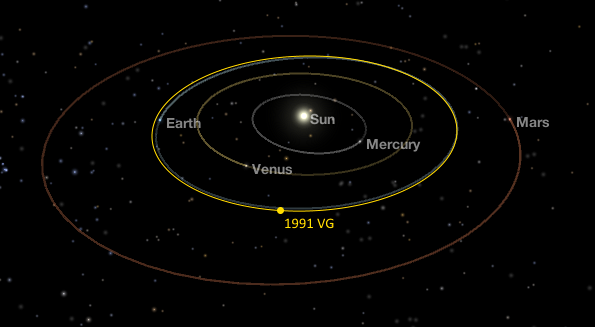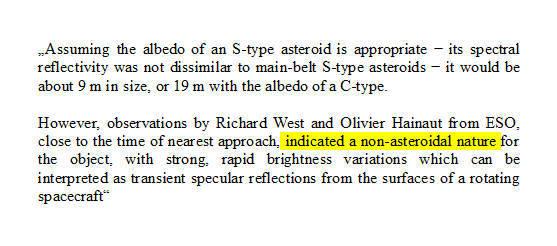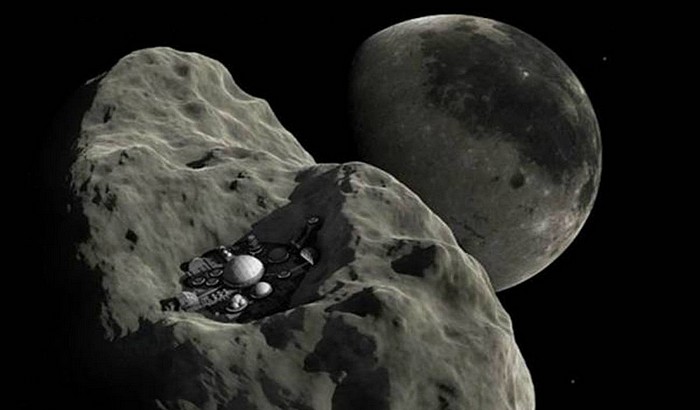It looks like you're using an Ad Blocker.
Please white-list or disable AboveTopSecret.com in your ad-blocking tool.
Thank you.
Some features of ATS will be disabled while you continue to use an ad-blocker.
share:
A 25-year-old space mystery remains unsolved up to this day: it involves an unusual
Near-Earth-Object, about 10 meters in size, displaying unusual brightness variations and
moving on an almost Earth-like heliocentric orbit. The object, which was discovered in the early nineties and later dubbed 1991 VG, might have
qualified for a normal asteroid if it wouldn't have been for astronomer Duncan Steel, who investigated the object and concluded the following in an
essay published in 1995:
Visualization of 1991 VG's orbital path around the sun:
Four years earlier, astronomer James Vernon Scotti, discovered 1991 VG when it had its (almost) closest approach to Earth and came into view of the 0.91-m Spacewatch telescope in Arizona:
In his article, Duncan Steel considered a "returning spacecraft" (eg. Apollo, Pioneer, Luna, Venera etc.) to be the culprit for the anomalous behaviour of 1991 VG. He also looked into possible asteroids that could have been on the same trajectory, but both explanations have - more or less - been dismissed:

As far as I know, the debate is still up. But no matter whether 1991 VG is of human, natural or alien origin, I believe Duncan's essay achieved something more profound than to just investigate 1991 VG. He managed to make a case for the general possibility of ET technology having been deployed in our solar system in the remote past (and hinted at the fact that potential alien tech may still be around today just waiting to be discovered).
Undoubtedly, a lot of new near-Earth objects have been discovered since 1991 and many of us might be convinced that 1991 VG is nothing but an unusual asteroid, maybe the remains of a lunar impact or some kind of debris of a man-made object. However, I believe Duncan's theory hasn't been disproven yet. 1991 VG will fly past Earth again in Summer 2017, where it can be seen in the southern hemisphere.
Then, we will hopefully know what we're dealing with!
 Image source
Image source
Note: I'm aware that there have been several threads about this topic before, but I thought it would be good to compile the information and sources into a new, more comprehensive OP (apart from this becoming relevant again due to the next pass of 1991 VG).
SOURCES AND LINKS:
--------------------------------------------------------------------
1. The Observatory, vol. 115, p. 78-83 (1995)
2. 2007 thread on ATS
3. 2008 thread about 1991 VG
4. Video: Mysterious Objects In The Solar System
5. More recent article about 1991 VG on Motherboard
6. Article on www.anomalist.com
7. 2012 thread about 1991 VG
8. NEO 1991 VG on Wikipedia
9. Info about James Vernon Scotti
10. Duncan Steel CV
11. The Spacewatch Project, University of Arizona
"The above [analysis] has been intended to provide prima facie evidence that 1991 VG is a candidate alien artifact. The alternative explanations - that it was a peculiar asteroid, or a man-made body - are both estimated to be unlikely, but require further investigation."
Duncan Steel, SETA and 1991 VG, The Observatory, vol. 115, p. 78-83 (1995)
Visualization of 1991 VG's orbital path around the sun:

Four years earlier, astronomer James Vernon Scotti, discovered 1991 VG when it had its (almost) closest approach to Earth and came into view of the 0.91-m Spacewatch telescope in Arizona:
November 6, 1991 began as a relatively routine night for astronomer James Scotti. Working at the University of Arizona’s Kitt Peak observatory, Scotti was scanning the cosmos for asteroids when he discovered a small, fast moving object with highly unusual features. Only about 10 meters in diameter, the object exhibited an anomalous rate of rotation, fluctuations in brightness and speed for its size, suggesting to Scotti that it was something other than your “run-of-the-mill” main belt asteroid. Stranger still, the object was in a heliocentric orbit remarkably similar to that of Earth.
In his article, Duncan Steel considered a "returning spacecraft" (eg. Apollo, Pioneer, Luna, Venera etc.) to be the culprit for the anomalous behaviour of 1991 VG. He also looked into possible asteroids that could have been on the same trajectory, but both explanations have - more or less - been dismissed:

As far as I know, the debate is still up. But no matter whether 1991 VG is of human, natural or alien origin, I believe Duncan's essay achieved something more profound than to just investigate 1991 VG. He managed to make a case for the general possibility of ET technology having been deployed in our solar system in the remote past (and hinted at the fact that potential alien tech may still be around today just waiting to be discovered).
Over the past two decades various authors have debated whether the best place to look for such artifacts is in the asteroid belt, in the outer Solar System, on planetary surfaces, or as extra terrestrial probes in the inner Solar System, whereas the famous Fermi Paradox argument is based upon the understanding that such probes have not been detected, and thus extraterrestrial intelligent beings do not exist. The aim of this communication is to point out [...] that an extraterrestrial spaceprobe may have been detected in late 1991 in near-Earth space.
Undoubtedly, a lot of new near-Earth objects have been discovered since 1991 and many of us might be convinced that 1991 VG is nothing but an unusual asteroid, maybe the remains of a lunar impact or some kind of debris of a man-made object. However, I believe Duncan's theory hasn't been disproven yet. 1991 VG will fly past Earth again in Summer 2017, where it can be seen in the southern hemisphere.
Then, we will hopefully know what we're dealing with!

Note: I'm aware that there have been several threads about this topic before, but I thought it would be good to compile the information and sources into a new, more comprehensive OP (apart from this becoming relevant again due to the next pass of 1991 VG).
SOURCES AND LINKS:
--------------------------------------------------------------------
1. The Observatory, vol. 115, p. 78-83 (1995)
2. 2007 thread on ATS
3. 2008 thread about 1991 VG
4. Video: Mysterious Objects In The Solar System
5. More recent article about 1991 VG on Motherboard
6. Article on www.anomalist.com
7. 2012 thread about 1991 VG
8. NEO 1991 VG on Wikipedia
9. Info about James Vernon Scotti
10. Duncan Steel CV
11. The Spacewatch Project, University of Arizona
edit on 22-5-2016 by jeep3r because:
fixed URL
Makes me wonder if it is a leftover from the supposed collision that gave us our moon. Maybe the variations are due to gravitational pull of
planetary bodies that gives it an orbit that isn't... shall I say Newtonian?
I am no expert but I am not ready to write in "alien" in the blank yet. Every time we run across something new (though this appears to be approaching 2 decades of being known) we scramble to try and find plausible explanations. Until we get a closer look at this object then we may gain a better understanding of it.
We will just have to wait till 2017 when it gets close enough to give it a good observation.
Until then... just another "interesting object" we can speculate on.
I am no expert but I am not ready to write in "alien" in the blank yet. Every time we run across something new (though this appears to be approaching 2 decades of being known) we scramble to try and find plausible explanations. Until we get a closer look at this object then we may gain a better understanding of it.
We will just have to wait till 2017 when it gets close enough to give it a good observation.
Until then... just another "interesting object" we can speculate on.
edit on 22-5-2016 by Terminal1 because: Too big of fingers typing on too small a keyboard... typos galore.
a reply to: Terminal1
I think the mystery regarding this object is that if it were simply a wandering rock in an orbit similar to the Earth, its orbit should have degraded or changed, as without some kind of artificial correction it couldn't remain where it is.
I am fairly certain it is that, but it has been ages since I read anything about this object, so I have a bit of reading up to do.
--------------------------------------------------
Nice reminder OP, thanks for this, oh and great job in the presentation!
I think the mystery regarding this object is that if it were simply a wandering rock in an orbit similar to the Earth, its orbit should have degraded or changed, as without some kind of artificial correction it couldn't remain where it is.
I am fairly certain it is that, but it has been ages since I read anything about this object, so I have a bit of reading up to do.
--------------------------------------------------
Nice reminder OP, thanks for this, oh and great job in the presentation!
a reply to: Jonjonj
Wouldn't that apply to Earth's orbit too?
I think the mystery regarding this object is that if it were simply a wandering rock in an orbit similar to the Earth, its orbit should have degraded or changed, as without some kind of artificial correction it couldn't remain where it is.
a reply to: Phage
If Earth had interactions with much more massive bodies, I am sure it would. I think this object has had interactions with the Earth before though.
Again, I am going on (possibly false) memory here.
Edit to add:
Above from the wiki.
Bold is mine. Both bolded points are relevant, both for and against the "mystery"
If Earth had interactions with much more massive bodies, I am sure it would. I think this object has had interactions with the Earth before though.
Again, I am going on (possibly false) memory here.
Edit to add:
On November 6, 1991, Scotti discovered a faint object which was designated 1991 VG soon after discovery.[4] The object's heliocentric orbit was found to be very similar to Earth's orbit[5] and it was calculated that it would make a close approach to Earth just a month after discovery (on December 5, 1991[2]). Given such an Earth-like orbit, the dynamical lifetime of such an object is relatively short with the object quickly either impacting Earth or being perturbed by Earth onto a different orbit. The similarity of its orbit with Earth was also very difficult to explain from natural sources, with ejecta from a recent Lunar impact or non-gravitational perturbations such as the Yarkovsky effect having been suggested.[6] The first Earth Trojan asteroid - 2010 TK7 has been identified and such objects could well be a source for objects like 1991 VG.
Above from the wiki.
Bold is mine. Both bolded points are relevant, both for and against the "mystery"
edit on 22-5-2016 by Jonjonj because: edits are free
1991 VG was discovered by Jim Scotti. Here is part of his discussion about it:
www.satobs.org...
So, the debate is still alive, and may continue to be so until someone can recover it next time it comes back around and then someday we can go out and take a close look. Does it have a regolith or a rocky surface or does it have "USA" or "CCCP" painted on the side? My guess is that it is indeed a natural object, but if it is manmade, perhaps it is a Saturn IVB stage from one of the early Apollo missions. As I recall, at least one left the 3rd stage in a high Earth orbit that would have eventually been perturbed into solar orbit.
www.satobs.org...
a reply to: Jonjonj
I just would rather write "mundane explanation" first before alien. I love science because once one question is answered, two (or more) tend to arise.
I mean I would absolutely love if it were some sort of alien tech or outpost or something. But It isn't my go to answer when something is unexplained.
It is interesting though... and I am excited to see if something comes of this, mundane or not. We think we are so smart but in the scheme of things we are barely trying to figure out how not to poop in our diapers.
I just would rather write "mundane explanation" first before alien. I love science because once one question is answered, two (or more) tend to arise.
I mean I would absolutely love if it were some sort of alien tech or outpost or something. But It isn't my go to answer when something is unexplained.
It is interesting though... and I am excited to see if something comes of this, mundane or not. We think we are so smart but in the scheme of things we are barely trying to figure out how not to poop in our diapers.
a reply to: Jonjonj
I can't put an argument there... if I suspend disbelief and go with "what if..." I could have a lot of fun with. Probably write a novella about this particular object.
"What if..." is a two edged sword. I mean it could be something wonderful which grows our knowledge and understanding. But I also bet that "what if..." can also be put in the list of "famous last words".
I can't put an argument there... if I suspend disbelief and go with "what if..." I could have a lot of fun with. Probably write a novella about this particular object.
"What if..." is a two edged sword. I mean it could be something wonderful which grows our knowledge and understanding. But I also bet that "what if..." can also be put in the list of "famous last words".
a reply to: jeep3r
That part sparks my curiosity.
Fluctuating brightness could be explained by rotation. What would account for fluctuating speed and what does he mean by 'fluctuating?' Is the speed a fact based on a snapshot or from long observation.
These are just initial thoughts and questions.
[...]fluctuations in brightness and speed for its size
That part sparks my curiosity.
Fluctuating brightness could be explained by rotation. What would account for fluctuating speed and what does he mean by 'fluctuating?' Is the speed a fact based on a snapshot or from long observation.
These are just initial thoughts and questions.
originally posted by: Terminal1
a reply to: Jonjonj
"What if..." is a two edged sword. I mean it could be something wonderful which grows our knowledge and understanding. But I also bet that "what if..." can also be put in the list of "famous last words".
You mean something like: What if we just ignore those darned alien thingies?

originally posted by: Kandinsky
a reply to: jeep3r
That part sparks my curiosity.
Fluctuating brightness could be explained by rotation. What would account for fluctuating speed and what does he mean by 'fluctuating?' Is the speed a fact based on a snapshot or from long observation.
These are just initial thoughts and questions.
First off, thanks to all who have replied to this thread so far, that's really appreciated!
I'm sure there are more than a handful of people on here that might shed some light on 1991 VG based on their interest and experience in astronomy-related subjects. As for myself, I think there's not a whole lot I'll be able to add but I think the discovery is quite intriguing, hence the thread.
As for the rotation, here's an excerpt from one of the sources from the OP:
Yet according to Scotti, in the years since he spotted 1991 VG, it was discovered that a significant portion of asteroids under 100 meters have remarkably fast rotation periods. Thus for an object as small as 1991 VG, a rotation period of a few minutes, while rare, is not impossible. It would simply mean that the object is a monolithic structure, a small boulder, rather than a rubble pile.
The above doesn't address the brightness variations, though. But it's obviously the combined observations that made Duncan doubt that this is a natural or man-made object.
edit on 22-5-2016 by jeep3r because: text
That's a lot of math and speculation to not produce a single image.
Does an image of this exist?
Does an image of this exist?
Yeah, this was one of the "Hmmm ... might be a real anomaly" for me. I hadn't registered the speed variations, which might be explained by gravity
wells catching and accelerating it, though I'd think that would be the first thing explored?
I remember someone matched the reflective qualities to the white titanium in Apollo era spacecraft (if the same object I'm remembering) ... but as I don't do spectra-analysis I cannot know for sure, and who's to say it isn't an artifact from some high tech 'olden days' or that aliens find white titanium handy, too?
Though really, anything truly alien has a much higher % chance of being totally incomprehensible-unidentifiable to us humans!
I remember someone matched the reflective qualities to the white titanium in Apollo era spacecraft (if the same object I'm remembering) ... but as I don't do spectra-analysis I cannot know for sure, and who's to say it isn't an artifact from some high tech 'olden days' or that aliens find white titanium handy, too?
Though really, anything truly alien has a much higher % chance of being totally incomprehensible-unidentifiable to us humans!
new topics
-
Outgoing Lame Duck BIDEN Officials and Democrats Voice Their Regrets.
2024 Elections: 2 hours ago -
Reflections of Elections past
US Political Madness: 4 hours ago -
President Carter has passed
Mainstream News: 6 hours ago -
Get Reday - Here comes the Bird Flu Pandemic - Millions are Notified
Diseases and Pandemics: 6 hours ago -
2 Guys die hunting Bigfoot
Cryptozoology: 7 hours ago -
Joe Rogan and The Black Keys Diorama
General Entertainment: 9 hours ago
top topics
-
Get Reday - Here comes the Bird Flu Pandemic - Millions are Notified
Diseases and Pandemics: 6 hours ago, 16 flags -
President Carter has passed
Mainstream News: 6 hours ago, 15 flags -
2 Guys die hunting Bigfoot
Cryptozoology: 7 hours ago, 6 flags -
Reflections of Elections past
US Political Madness: 4 hours ago, 5 flags -
Outgoing Lame Duck BIDEN Officials and Democrats Voice Their Regrets.
2024 Elections: 2 hours ago, 4 flags -
Joe Rogan and The Black Keys Diorama
General Entertainment: 9 hours ago, 3 flags
active topics
-
Why Such An Uproar Over Non-US Citizens With H1-B Work Visas.
Social Issues and Civil Unrest • 79 • : cherokeetroy -
President Carter has passed
Mainstream News • 11 • : Lumenari -
Get Reday - Here comes the Bird Flu Pandemic - Millions are Notified
Diseases and Pandemics • 17 • : WeMustCare -
Outgoing Lame Duck BIDEN Officials and Democrats Voice Their Regrets.
2024 Elections • 3 • : SteamyAmerican -
This is why ALL illegals who live in the US must go
Social Issues and Civil Unrest • 35 • : charlyv -
2 Guys die hunting Bigfoot
Cryptozoology • 15 • : Lumenari -
Danish Prime Minister said to keep 3 days worth of canned goods on hand
World War Three • 16 • : Irishhaf -
New UK Petition - Close the borders! Suspend ALL immigration for 5 years!
Regional Politics • 9 • : Astrocometus -
-@TH3WH17ERABB17- -Q- ---TIME TO SHOW THE WORLD--- -Part- --44--
Dissecting Disinformation • 3845 • : Guyfriday -
Reflections of Elections past
US Political Madness • 2 • : charlest2
